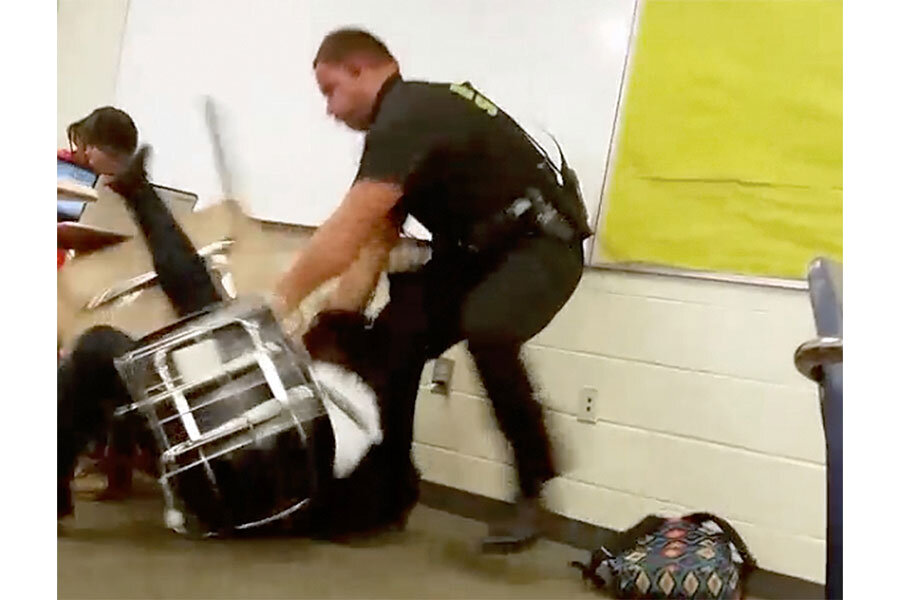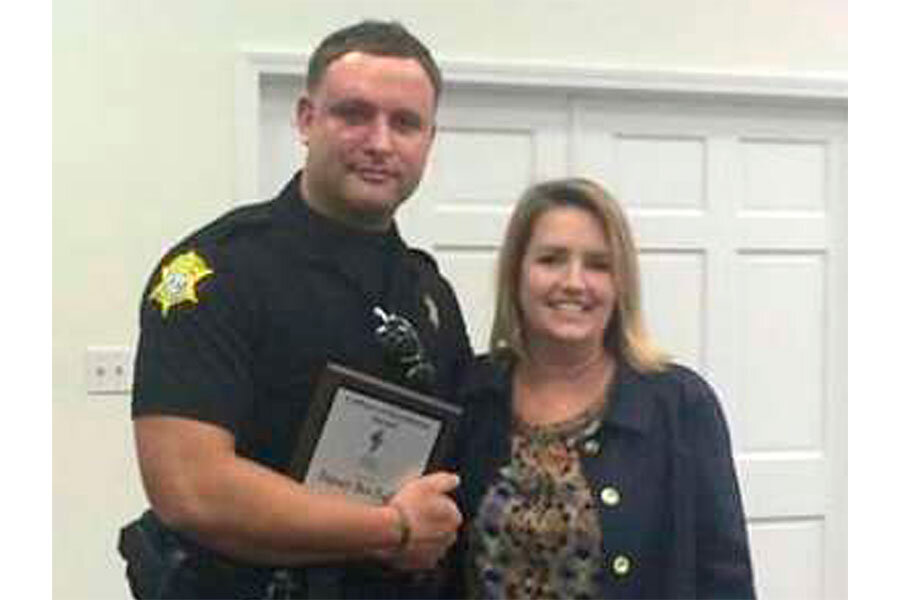S.C. video spotlights police in schools: Do they help or hurt?
Loading...
The video is barely 90 seconds long, but it has sparked a heated debate about police in schools.
The video – recorded in a classroom at Spring Valley High School in Columbia, S.C., and posted online Monday – shows a school resource officer approaching a black teenager at her desk. She had been asked to leave the class multiple times for causing a disruption but refused.
"You’re either going to come with me, or I’m going to make you," says the officer, Richland County Sheriff’s Deputy Ben Fields.
Seconds later, Mr. Fields slams her desk to the ground – with her still in it – then tosses her across the room and handcuffs her.
Fields has been placed on administrative leave and banned from school district property. Both the Richland County sheriff and the chairman of the school district’s board of trustees have said the video is disturbing, and federal authorities opened a civil rights probe into the incident on Tuesday.
Yet just last year, Fields received the school district’s “Culture of Excellence Award” for being “an exceptional role model to the students he serves and protects,” according to a sheriff’s department newsletter.
In that way, the incident – and the man at the center of it – embody the fundamental debate surrounding programs that put police in schools: Do they work in making schools safer, or do they make things worse by blowing minor problems out of proportion?
As the number of school resource officers, or SROs, in American schools increases dramatically, the results have been decidedly mixed.
Some research has shown that an increased police presence in schools leads to more offenses of all types – whether serious or frivolous – being referred to law enforcement, resulting in police inappropriately replacing teachers as disciplinarians. Critics say SROs make schools feel more like jails.
But police officers in schools can give parents peace of mind about their childrens' safety, and they also can improve young people's perceptions of law enforcement, which is particularly important given the current lack of public confidence in police, some experts say.
To supporters, the South Carolina incident was an unfortunate anomaly, seemingly confirming critics' worst fears while eclipsing the good that the programs do.
Whether or not Fields was legally justified in his actions, "One terrible incident like this can really undo a huge amount of investment in promoting good relationships," says Emily Owens, an associate professor of criminology at the University of Pennsylvania, who has researched SRO programs.
A complicated history
SROs have become widespread, spurred by federal funding in response to the country’s crime spike in the 1980s and ’90s and, later, high-profile school shootings. In 1975, 1 percent of United States schools had SROs. By 1997, that figure had increased to 22 percent, and in 2007 – the last year for which data are available – the figure was 40 percent.
While the video is "shocking and disturbing," it is a rare occurrence, says Dr. Owens. "Most SROs do not do this in the classroom."
Yet Fields’s mixed history as a police officer speaks to deeper concerns about such programs.
He joined the Richland County Sheriff's Department in 2004 and has been an SRO since 2008. He wasn’t unpopular with students at Spring Valley High, where he was also a defensive line and strength coach for the football team.
"Deputy Fields was always nice to everyone," Quentin Jones, a Spring Valley High sophomore, told The New York Times.
But the student added: "No matter how cool he is, there’s no reason for him to do that to a lady."
Fields has been a target for criticism in the past, as well. He was the subject of an excessive force lawsuit in 2007 that was dismissed, and he is one of 10 defendants named in a lawsuit by a former Spring Valley student who claims he was unlawfully expelled from the school in 2013, in part because of an investigation led by Fields that claimed the student was involved in a "huge gang fight."
The student, Ashton Reese, alleges in his complaint that Fields "recklessly targets African-American students with allegations of gang membership and criminal gang activity." The jury trial is scheduled for late January.
Fields’s experience illustrates some issues with SRO programs nationwide, Owens says. Often, SROs are not well trained for the kinds of incidents they'll encounter in schools.
"Officers get a lot of training on how to deal with low-frequency, high-intensity events, like how you respond to an active shooter," she says. "I know of a lot fewer big-city police agencies that train officers in more-common but equally important low-stress events."
A school or a jail?
For Shaun Harper, executive director of the Center for the Study of Race and Equity in Education at the University of Pennsylvania, the situation is much more clear-cut.
He says he was "mortified" when he watched the video.
"It is a classic example of excessive force," he says. "This guy just didn’t have to rough this girl up."
All these incidents do is drive another wedge between police and the communities they’re working to protect and serve, Dr. Harper says.
"It only exacerbates the problem of the disconnect between blacks and police," he says. "It just reinforces that we need to be afraid of them."
Research has shown that even the briefest interaction with the criminal justice system, like being arrested but not charged, can have profound consequences on juveniles' future, and that black students are disciplined more frequently, and more severely, than white students. This trend is even starker in Richland County, where 82 percent of juvenile referrals to law enforcement were black students, compared with 14 percent for white students, according to data from the South Carolina Department of Juvenile Justice. That marked the biggest racial disparity of any county in the state.
"Having these uniformed authority figures in the school, I think it actually makes the school feel less like a school and more like a jail," says Harper.
Researchers like Owens point to positive larger trends in SRO programs. A University of Maryland study found that the typical SRO spends half of his or her time on law enforcement activities, 25 percent on mentoring or counseling students, and 13 percent on teaching, with the rest on other tasks. Owens’s own research has found that SRO programs have helped law enforcement agencies make more arrests off-campus.
Harper counters that the expansion of SRO programs is frustrating given the alternatives available, including restorative justice methods that promote mediated discussions among victims, offenders, and teachers – which have proved successful.
"I absolutely think the cons outweigh the pros," he says. "We know from the school discipline research that there are numerous alternatives to suspensions, expulsions, and having cops in schools."









